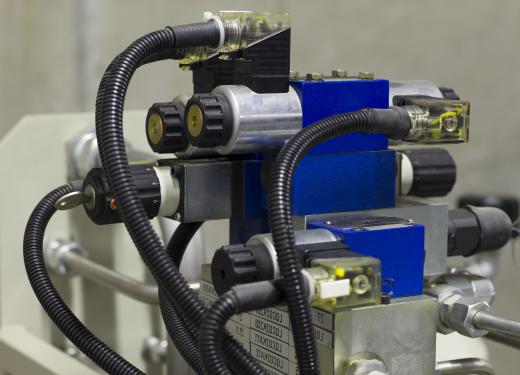A micro solenoid is an electronically controlled valve that either is very small or can control very small amounts of fluid. Valves that have been miniaturized in size to micro-scale are useful in medical devices. On a slightly larger scale, small solenoid valves can be designed to control extremely small quantities of fluids. These valves are useful in medical dispensing or laboratory analytical equipment requiring micro-quantities of medicines or reagents.
Miniature solenoids were developed in the late 20th century to support growing interest in implantable or portable dispensing equipment. Patients undergoing chemical treatment often require continuous low-quantity drug delivery. This treatment may be continued outside of a hospital or medical facility to promote well-being. A micro solenoid delivery system links the control valves to a microprocessor to deliver the drug therapy at a prescribed rate. Batteries can operate the system because the micro solenoid requires very little power.

Control of small quantities of fluids is used for in-room medical supply equipment, in air control systems and in pilot plant operations for small-scale manufacturing. A room delivery system can provide small quantities of drugs similar to a portable system, with a power cord supplying electricity. Air control using micro solenoids has been used in movable, or articulating, artificial limbs. Similar air-controlled valves can be used for chemical delivery to pilot plant operations.
Another common use of a micro solenoid is in laboratory analytical equipment. Liquid and gas chromatography and other devices use very small quantities of reagents and fluids being tested. Early versions of these machines required technicians to manually add these materials as needed. An interest in automation has resulted in machines that are programmed to add chemicals using solenoid valves. These automatic testing systems are dependable and provide reliable and reproducible test results.
This technology can be used for turning fluid flows on or off as well as controlling them. Some medical devices require rapid start and stop controls, perhaps for drug delivery, to control a micro-pump, or to act as an emergency stop. A micro solenoid shows excellent high-speed reaction time and can be used as a pinch valve for plastic tubing or a stop valve for gases or liquids.
Aerospace research is another are where micro solenoids are used. Pulse motors provide thrust to missiles and rockets by supplying fuel in a rapid series of pulses, creating a repeating detonation. Micro solenoids have been shown to work at the 100-plus cycles per second or higher frequencies that pulse motors require. Testing has also shown micro solenoids to have lifetimes of millions of open and close cycles, which provides excellent durability and reliability.
